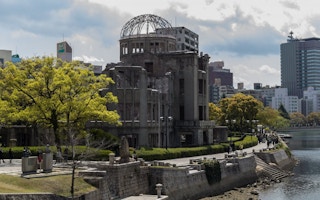If a nuclear war should ever break out, any survivors could have to cope not just with the immediate effects of blast and radioactivity, but with climate mayhem as well: global cooling with unknowable consequences.
The wildfires in the Canadian province of British Columbia in the summer of 2017 were the worst the region had ever seen. They were so bad that the smoke from the sustained blaze rose 23 kms into the upper stratosphere and stayed there for eight months.
And that has given US scientists the chance once again to model the consequences of a nuclear winter after thermonuclear war.
“This process of injecting soot into the stratosphere and seeing it extend its lifetime by self-lofting was previously modelled as a consequence of nuclear winter in the case of an all-out war between the United States and Russia, in which smoke from burning cities would change the global climate,” said Alan Robock, an environmental scientist at Rutgers University.
“Even a relatively small nuclear war between India and Pakistan could cause climate change unprecedented in recorded human history, and global food crises.”
Professor Robock and colleagues report in the journal Science that they used computer simulations and satellite observations to test an old worry: what happens when black carbon or other obstructions get into the stratosphere. Sulphate aerosols discharged to stratospheric heights from volcanoes have been observed to lower global average temperatures.
The eruption of Mt Pinatubo in the Philippines in 1991 blasted 20 million tonnes of sulphur dioxide into the stratosphere and lowered global temperatures by around 0.5°C, and the same observations have prompted scientists to propose an untested and potentially dangerous solution to runaway global heating, by spraying aerosols into the upper atmosphere.
The unprecedented fires in British Columbia that began in July 2017 provided them with experimental evidence: the devastation was so bad that 40,000 people were evacuated from their homes and the provincial government declared a state of emergency that lasted 10 weeks. Altogether the fires destroyed 1.2 million hectares of forest and caused $564m worth of damage.
What interested the US scientists was the smoke. It formed a pyrocumulonimbus cloud larger than any ever observed before and rose 12 kilometres. There was hardly enough mass in the plume to cool the planet in any measurable way, but it had bulk enough to provide information on how the cloud dispersed and how it lingered.
The soot in the cloud absorbed solar radiation and the air around each particle became hotter, which made it rise even further. Within two months, it had reached 23kms. The stratosphere is above the rain clouds, so there was nothing to wash the soot down again. The stratosphere is also home to the jet stream, and high winds took the soot around the whole hemisphere.
Future unpredictable
And that gave Professor Robock and his colleagues the chance to test models of what might happen if, instead of forest fires, the smoke had come from cities reduced to ash by a thermonuclear exchange.
The smoke from British Columbia held 300,000 tonnes of soot. A nuclear war between India and Pakistan however could put 15 million tonnes into the upper atmosphere, and a war between the US and Russia could generate 150 million tonnes.
Nobody knows what then might happen. More than 30 years ago, US scientists raised the spectre of nuclear winter: a world in which sunlight was weakened, summers were cancelled, and harvests failed.
The hypothesis was, thankfully, never put to the test, and in any case was challenged by other scientists. The Canadian fires, themselves perhaps made more devastating by global warming, delivered some vital clues. The next step is to apply the evidence from 2017 to see whether, after a nuclear war, the much-feared enduring winter would follow.
“The observed rapid plume, latitudinal spread, and photochemical reactions provided new insight into potential global climate impacts from nuclear war,” the scientists write.
This story was published with permission from Climate News Network.










